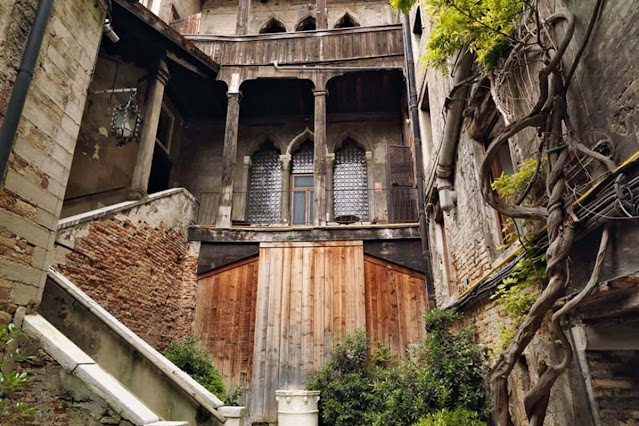Venetians called this place “The House of the Magician.” It’s where Mariano Fortuny, who became world famous for his outrageously gorgeous fabrics, gowns, and lamps, set up his home and workshop in 1907. There was a woman behind his success: Henriette Negrin, who he met in Paris in 1897 when she was a French widow, a model, and a seamstress. She became his muse, collaborator, and wife—after they lived together for twenty-two years.
You’ll see Fortuny’s paintings of Henriette here—some nude, others with her dressed elegantly with her hair swept up, along with photographs of their trips to Greece and Egypt, where Fortuny got lots of inspiration. In the museum where they once lived and worked together, you enter the world of this eccentric, twentieth-century Renaissance man. Fortuny was born in Granada in 1871, to both a father and grandfather (on his mother’s side) who were highly acclaimed painters in Spain.
His father died when he was three, so his mother took him to live in Paris, and also traveled about, until they finally settled in Venice, because Fortuny was horribly allergic to horses, and this was the only place around without carriages. After his early artistic endeavors in painting and photography, and success in designing sets and lighting for theater, Fortuny, at thirty-six years old, began his work on printed fabrics here with Henriette. He’d already had an attic studio in the thirteenth-century palazzo, and then bought the building that had been cut up into apartments and gutted it, turning it into a free-flowing creative space.
The walls of the first floor’s large rectangular room are covered with Fortuny’s patterned fabrics, creating a warm, exotic, colorful ambiance. His paintings and lamps surround displays of his gowns and capes that were worn by such illustrious women as Eleanora Duse, Sarah Bernhardt, and Isadora Duncan. Fortuny broke into the woman’s fashion world in 1907 with his Delphos gown, inspired by tunics from ancient Greek statuary.
It was simple and finely pleated, in soft, shimmering colors. Women happily tore off their corsets to put on the sensational dress that elegantly draped their bodies. He packaged it rolled up in a hatbox, so it was easy and light for travel. The second floor of the museum gives you an idea of what life was like when 100 workers were there producing Fortuny fabrics, under Henriette’s supervision. In contrast to what’s below, it’s stripped bare with only huge worktables.
Off to the side is Fortuny’s library and personal workshop, where you’ll get a hit of the practical side of this free-spirited artist. It’s packed with volumes of books about artists who came before him, lots of journals where he cataloged designs and colors, his paints and tools. Fortuny’s preferred entrance to this palazzo was climbing through the skylight, straight into his workshop. Fortuny’s fabric designs, of intricate swirls, animals, and geometric prints, on cotton, silk, or velvet, clearly show his influences from Spain and travels to Greece and farther east.
But ultimately, they’re completely Venetian, reflecting the cultural melting pot of the city, with rich colors muted by the city’s fog, or glistening in gold or silver sunlight. He was called “the magician” because nobody could figure out exactly how he produced these fabrics, and his techniques are still kept secret. You’ll be so tempted to reach out and touch them in the museum, but you can’t.
For a tactile experience, head to the Fortuny Showroom on Giudecca, or one of the Venetia Studium stores in Venice, where you can even buy a scarf, pillow, purse, or lamp to take home and keep a little bit of the Venetian magician in your life. Palazzo Fortuny Museum: Campo San Beneto (San Marco), 10-6, closed Tuesday.









No comments:
Post a Comment